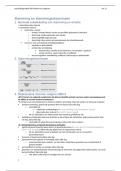Samenvatting
Summary of the course Web Technology at the VU Amsterdam
- Instelling
- Vrije Universiteit Amsterdam (VU)
This summary captures all subjects of the web technology course, given at the Vrije Universiteit Amsterdam. At the time of writing, it was given for first year bachelor students AI at the VU. It captures mainly the three main parts of web technology, namely HTML, CSS, and JavaScript. However, it a...
[Meer zien]













